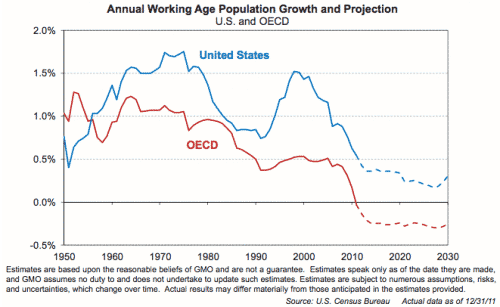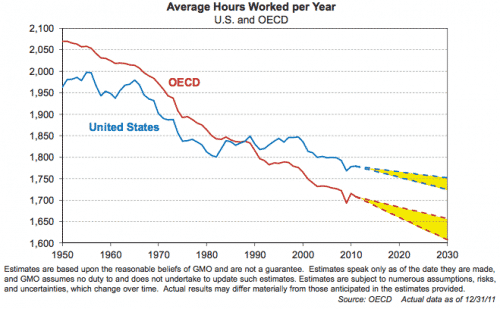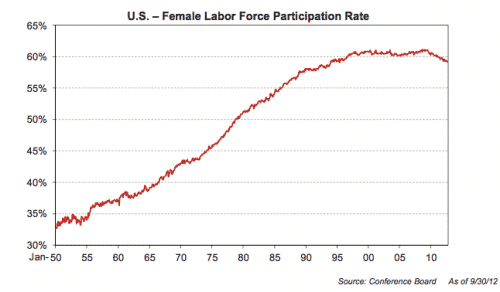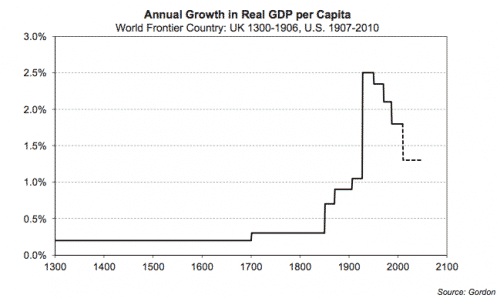Grantham: America is on its way to zero growth with heavy consequences
Jeremy Grantham’s quarterly piece is out now and the important topic is the lack of growth in the US. The way that Grantham paints the picture – and I believe this is an accurate depiction – the US is not just suffering from a cyclical growth slowdown but faces a secular growth slowdown of monumental proportions, especially in view of the promises the US government has made to current and future pensioners. All of this is happening against a backdrop of eroding productivity growth that sets the US up for some difficult challenges ahead. And Grantham also discusses his view on peak resources and why he believes peak resources and environmental change are the biggest issues facing modern economies.
Here are the bullet points that Grantham used to summarise his view:
- The U.S. GDP growth rate that we have become accustomed to for over a hundred years – in excess of 3% a year – is not just hiding behind temporary setbacks. It is gone forever. Yet most business people (and the Fed) assume that economic growth will recover to its old rates.
- Going forward, GDP growth (conventionally measured) for the U.S. is likely to be about only 1.4% a year, and adjusted growth about 0.9%.
- Population growth that peaked in the U.S. at over 1.5% a year in the 1970s will bob along at less than half a percent. This is pretty much baked into the demographic pie. After adjusting for fewer hours worked per person, man-hours worked annually are likely to be growing at only 0.2% a year.
- Productivity in manufacturing has been high and is expected to stay high, but manufacturing is now only 9% of the U.S. economy, down from 24% in 1900 and 15% in 1990. It is on its way to only 5% by 2040 or so. There is a limit as to how much this small segment can add to total productivity.
- Growth in service productivity in contrast is low and declining. Total productivity is calculated to be just 1.3% through 2030, if we use current accounting methods.
- However, current accounting cannot accurately handle rising resource costs. Spending $150-$200 a barrel in offshore Brazil in the future to deliver the same barrel of oil that cost the Saudis $10 will result perversely in a huge increase in (Brazilian) GDP. In reality, rising resource costs should be counted as a squeeze on the balance of the economy, as they lower our total utility.
- Measuring the non-resource balance of the economy produces the correct effect. The share of resource costs rose by an astonishing 4% of total GDP between 2002 and today. It thus reduced the growth of the nonresource part of GDP by fully 0.4% a year.
- Resource costs have been rising, conservatively, at 7% a year since 2000. If this is maintained in a world growing at under 4% and a developed world at under 1.5% it is easy to see how the squeeze will intensify.
- The price rise might even accelerate as cheap resources diminish. If resources increase their costs at 9% a year, the U.S. will reach a point where all of the growth generated by the economy is used up in simply obtaining enough resources to run the system. It would take just 11 years before the economic system would be in reverse! If, on the other hand, our resource productivity increases, or demand slows, cost increases may decelerate to 5% a year, giving us 31 years to get our act together. Of course, with extraordinary, innovative breakthroughs we might do even better, but we certainly shouldn’t count on that. (Bear in mind that we don’t even know precisely why the prices started to rise so sharply in 2000.) Excessive optimism and doing little could be extremely dangerous.
- For a few years fracking will add helpfully to growth: my guess is that the benefit will peak at about 0.5% within fi ve years, but be modest over longer periods. The key concept here for understanding growth is to know when the maximum upward push will occur.
- Increasing climate damage, refl ected mainly in food prices and fl ood damage, is going to increase. With any luck this will not be severe before 2030 (we allow for a 0.1% setback) but it is very likely to accelerate between 2030 and 2050. A great deal will depend on our responses.
- The bottom line for U.S. real growth, according to our forecast, is 0.9% a year through 2030, decreasing to 0.4% from 2030 to 2050 (see table on Page 16). This is all done presuming no unexpected disasters, but also no heroics, just normal “muddling through.”
- GDP measures must be improved so that they begin to measure output of real usefulness or utility. The current mish-mash of costs and of “goods” and “bads” produces poor and even damaging incentives.
- Accurate measurements of growth must eventually include the full costs of running down our natural assets. True income (said Hicks) is meant to allow for sustained productive capacity, which our current measures clearly do not. If they had done so the developed countries might well have been in reverse for the last 20 years.
- Investors should be wary of a Fed whose policy is premised on the idea that 3% growth for the U.S. is normal. Remember, it is led by a guy who couldn’t see a 1-in-1200-year housing bubble! Keeping rates down until productivity surges above its last 30-year average or until American fertility rates leap upwards could be a very long wait!
- Some of the investment implications of this low growth outlook and the Bernanke optimism will be addressed next time (with luck!).
Wow, that’s a lot to unpack. Let’s look at it as four separate but inter-related issues: low real and nominal economic growth, rising demographic challenges, low productivity gains and peak resources.
Low and declining GDP growth
The first issue is that the US has already been experiencing low and declining real GDP growth for years. Grantham says rightly that this trend was masked during the past three decades by an increase in private debt. Before 1980, U.S. GDP growth was an astonishing 3.4% annualised. But after 1980, the trendline is lower even despite massive bubbles in technology and housing that left the private sector heavily indebted.
Rising demographic challenges
The question is “why is growth slowing?” Much of it has to do with demographics. Women are no longer entering the workforce on net, birthrates are slowing and the average age of the population is increasing. These three demographic aspects decrease population growth and the employment to population ratio and work to push down economic growth. Grantham also points specifically to the decreasing amount of hours worked per worker in the US as a demographic factor decreasing productivity gains. See the charts below.
I have talked a bit about the hours worked idea, where Europe’s decrease in hours worked has been greater than it has been in the US. See my 2009 post on cultural attitudes on work, leisure and wealth in Europe and America. The crux of the post is that both Europe and the US have seen hours worked drop dramatically since 1960. But the drop has been greater in Europe for cultural reasons. Productivity gains in manufacturing allowed this to occur without any loss in wealth before 1980. In fact, we saw significant gains in wealth. However, a globalised economy has seen manufacturing fall as a percentage of the economy in both the US and Europe. The result has been a shift toward lower productivity gains and a widening wealth and income gap.
We could overcome this loss in productivity growth by simply turning back the clock and increasing hours worked. Americans to a degree have done so, especially in the professional white collar classes. But I suspect, there will be great resistance to this solution, just as there is great resistance to the increase of oublic pension ages because people have fought hard for these benefits; they will not relinquish them without a fight. Therefore, it is inevitable in the coming years that GDP growth will slow. But, to be clear, the predictions of a continued trend down in hours worked should be called into question.
Low productivity gains
The next part of Grantham’s essay goes to productivity. I have already mentioned the fact that a switch to a services-led economy is something that lowers productivity growth. But it was interesting to see in Grantham’s essay that he mapped historic annual growth in real GDP per capital as measured by Northwestern University Professor Robert Gordon. And what he found was that the two centuries or so of economic growth have been completely out of line with the historic trend. Grantham flags the issue of carbon-based resource use and the industrial revolution. He also flags the concept of environmental change and peak resources as a major reason that productivity gains in the future will be lower than anticipated. And I agree with Grantham that the focus has to be on trends in real resource utilisation as opposed to debt and monetary factors which are transient.
Peak resources
The key variable that adds downward pressure to this confluence of macro factors is peak resources. I subscribe to the view that key fossil fuels and other natural resources, being in limited supply, are in jeopardy of being increasingly unavailable. This is the view Grantham also presents. From a real resource perspective what it means is fewer natural resources available to maintain high levels of economic growth via either more man hours or higher productivity. From an economic standpoint, peak resources means higher costs for basic necessities that translates into a tax on lower income populations and socioeconomic groups. This will lead to geopolitical tensions within countries and between countries and raises the spectre of increased armed geopolitical conflict in the future.
Now, not every one is a believer in peak resources. In particular, because of the present Chinese capital nvestment bubble, it is highly probable that we will see a glut of industrial commodities in the very near (medium-term) future. Commodity analyst Edward Morse of Citigroup is predicting this just as he correctly predicted the collapse in oil prices in 2008. But this is a cyclical phenomenon that I believe will eventually be swamped by the secular phenomenon of peak resources.
Conclusion
From an investing perspective, one should see this as a dampener on returns. In particular, low real and nominal GDP growth should translate into increasingly onerous private and public pension burdens in the US and elsewhere in the developed economies even without peak resources as a factor. In my view, governments will turn to central banks to help ease the financial burden associated with this trend. However, this will only positively affect governments in nominal terms via inflation. In real terms, the burden will remain and the outlook is of diminished pension benefits for average citizens. In the private sector, large and older companies with defined benefit liabilities will not be able to relinquish the nominal or real burden and investment returns in their shares will suffer.
The peak resources aspect of this is the compelling wildcard. The data from Gordon suggests that increased natural resource use is the key determinant driving forward productivity gains and economic growth since the industrial revolution. So, to the degree an increase in use of those resources is constrained, we should expect even further diminished GDP growth.
Overall my view here is that the longer term secular outlook is not bleak but it requires governments to move away from infinite growth paradigms toward quality of life types of economic models. I don’t believe this kind of shift is possible without significant economic and political turbulence or without governments trying to manufacture growth via deficit spending, inflation and money printing. Because we are in the midst of a deflationary crisis due to high private debt, this creates a natural tension between deflationary and inflationary forces for the foreseeable future that should most benefit non-industrial commodities and precious metals as asset classes and least benefit large old-line industrial companies in developed economies.
Source: GMO (subscription required)




Comments are closed.